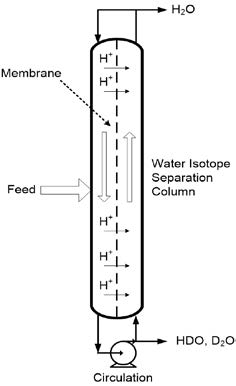Tech Briefs
Savannah River National Laboratory
Method to Scale Up Water Isotope Separation Process Using 2-D Membrane
Technology Overview
Savannah River National Laboratory has developed a novel method for separating isotopes from aqueous streams using 2-D membrane. This process can be used for water detritiation, removal and recovery of nuclear materials in processes and during environmental remediation.

Benefits
- Removing nuclear materials from water
- Decreases the needed storage capacity for contaminated water
- Efficient method to scale up membrane isotope separation process
Applications
- Water detritiation
- Heavy water enrichment
- Environmental restoration
Description
Efficient and economical water detritiation is very challenging for large quantities of tritium-contaminated water since tritium is part of the water molecule and exhibits almost identical chemical and physical properties to that of its non-radioactive counterpart. Recently graphene and other 2-D crystals were reported to sieve hydrogen isotopes with 10:1 H/D selectivity, and SRNL predicts even higher H/T selectivity at 58.5. However, typical nuclear operation requires much higher decontamination factor (DF) in the order of 1000 to million or even higher. To scale up and stage the membrane separation efficiently for water detritiation is the core of this patented technology. Methods include counter-current flow of an aqueous stream on either side of a separation membrane in a circulation loop. The separation membrane includes an isotope selective layer ( e.g., graphene) with electrochemical cell for hydrogen pumping. The isotopes selectivity across the membrane magically places lighter isotopes at top and heavier isotopes at bottom with many hundreds of separate stages, as illustrated with H/D example on the right. Beneficially, the methods can be carried out at ambient temperature and pressures and require no electrolysis of the water prior to the separation process. Moreover, the system design greatly simplifies the membrane separation process and can be scaled up economically. It is suitable to remove and recover tritium from contaminated water.
Intellectual Property
This technology and methods for its use have been granted US Patent No. 10,556,206 B2 (February 11, 2020), “Isotope Separation Methods and Systems” and is available for licensing.
Partnering Opportunities
SRNL invites interested companies with proven capabilities in this area of expertise to develop commercial applications for this process under a cooperative research and development agreement (CRADA) or licensing agreement. Interested companies will be requested to submit a business plan setting forth company qualifications, strategies, activities, and milestones for commercializing this invention. Qualifications should include past experience at bringing similar products to market, reasonable schedule for product launch, sufficient manufacturing capacity, established distribution networks, and evidence of sufficient financial resources for product development and launch.
Download Tech Brief
Contact Information
Savannah River National Laboratory
E-mail: partnerships@srnl.doe.gov